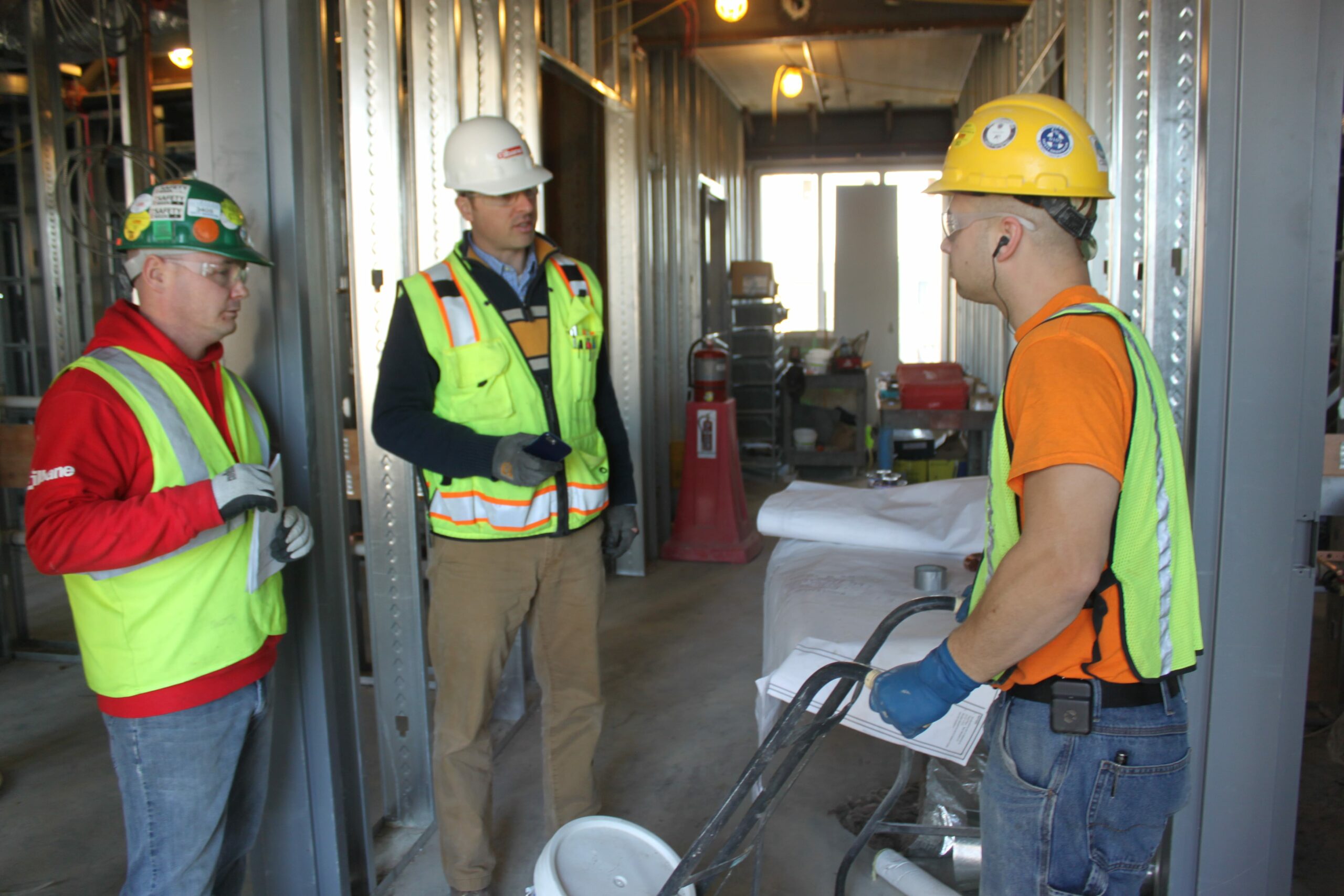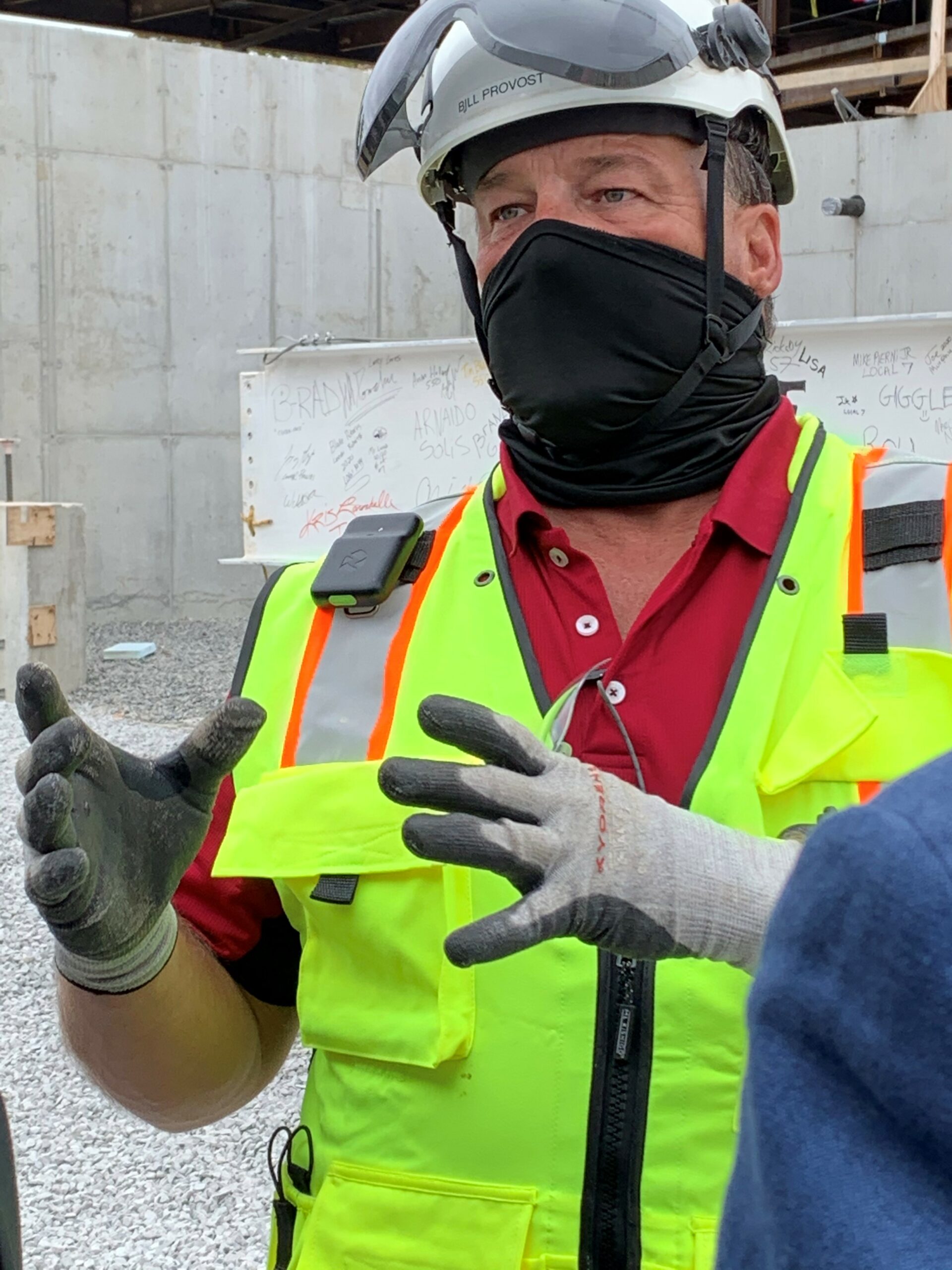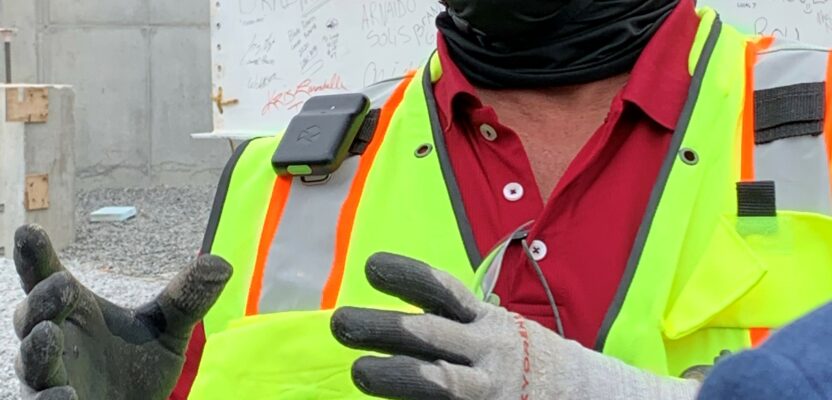IoT technology is helping workers maintain social distancing on the job site during the pandemic and making contact tracing easier. And it all starts with a beep.
Months into the pandemic, construction workers in the U.S. already know the drill by heart: don a hard hat, wear a mask, wash your hands and keep distancing from each other.
Although hard hats have always been part of a construction worker’s get-up, the three other rules set out in April by the U.S. Centers for Disease Control and Prevention (CDC) to stop the spread of COVID-19 at worksites are new.
Yet for folks in the construction business, the strictness of this “new normal” could just as well be a usual working day. Building workers have long been required to wear masks to prevent them from inhaling dust and toxic materials. Wash stations are also compulsory to remove potentially harmful substances such as paints and solvents from workers’ hands. And whenever needed, workers don protective gloves.
What’s tougher to put into practice is the last rule: maintaining social distance. Indeed, how can you make sure workers on construction sites stay at least six feet apart when they are constantly moving? Following that rule is remarkably challenging.
Jason Pelkey, though, was up for this challenge. Working as chief information officer for Gilbane Building Company, a global construction management company headquartered in Rhode Island, Pelkey saw a chance to use the latest technology to maintain on-site safety during this pandemic.
“I saw an opportunity for a device to help maintain COVID-19 public health protocols such as social distancing. So I called Triax and I found out that we were thinking exactly along the same lines,” recalls Pelkey.
Fighting the virus with ingenuity
Triax Technologies is a Connecticut-based company that specializes in wearable sensors for the construction industry.
“When our company was founded in 2012, our initial focus was on sports wearable technology. Then in 2017, we launched our Spot-r wearable device to provide real-time worker location and safety data in worksites. We have been operating in the construction market ever since,” says Robert Costantini, CEO of Triax.
Gilbane was one of the first users of Spot-r for its workforce. “We began working with Triax three years ago, using one of their wearable devices to help with safety such as injury alerts on large construction sites,” says Pelkey.
“So, I reached out to Triax and we discussed a new device that can be used to help maintain social distancing and provide tracking of interactions,” says Pelkey. “We wanted a device that would be incredibly useful to help with contact tracing in the event of a positive virus case.”

Engineers at Triax quickly went to work developing a solution to help Gilbane maintain safe social distances in their worksites. And in April 2020, Triax launched a new product called Proximity Trace. The product comes with a compact wearable device, the TraceTag, that is both lightweight and unobtrusive, allowing workers to attach it to a hard hat or wear it near the chest.
“Proximity Trace was created in direct response to the COVID-19 crisis. While many construction sites were being shut down at the start of the pandemic as companies and municipalities were reacting out of an abundance of caution, there were also a lot of the general contractors we work with that had many essential job sites they needed to keep safe and operational,” says Costantini. “We knew that speed was indispensable for essential workforces, and we also recognized this could be a path forward for non-essential businesses to re-open.”
Step away after the beep
People who have been in close contact with someone infected with the virus are at higher risk of becoming infected themselves. Thus, one of the ways to stop the spread of the virus, according to the World Health Organization, is via contact tracing. When persons who interacted with an infected individual can be traced and identified, they can then be given immediate medical attention and quarantine to help prevent them from infecting others.
Since the start of the pandemic, tech companies that produce apps, sensors and wearable devices have been in the forefront of coronavirus contact tracing. The most popular ones are smartphone-based apps that rely on Bluetooth signal for identifying potential human-to-human interactions. This approach is currently being successfully used in Austria, Canada and Germany. Singapore is also using Bluetooth for tracing, but has opted instead on embedding them in small tokens. Other countries like Bulgaria and South Korea have rolled out wristbands that record the movement of people using GPS satellite location data.
Workers who use Proximity Trace on construction sites, however, are relying on a somewhat comparable but smarter technology: the Internet of Things. In simple terms, IoT can be described as a set of digitally interconnected devices, from smartphones to wearable gadgets, that use sensors to collect and analyze data. Proximity Trace operates similarly, utilizing a low-cost, low-power sub-GHz network to connect sensors to each other and to a small number of gateways. The gateways, in turn, use traditional cellular networks to transport data to the Internet and process them on the Cloud.
As people move around and go about their jobs, Proximity Trace sensors work by constantly sweeping the surroundings looking for other sensors nearby. A sequence of beeps is then given off when a sensor finds itself close to another sensor.
“When workers who wear the device are standing close to each other, an alarm is triggered on the device so they know when they need to move away in order to observe the recommended social distancing rules,” says Ian Ouellette, vice president of product at Triax.
And this audible active feedback seems to be working.
“We have been using the device for over three months and our productivity at work has not been affected,” says Dan Parker, superintendent at Gilbane who oversees day-to-day worksite operations. “The alarm is loud enough to be heard by workers and the volume is adjustable.”
Parker, who has over 15 years of experience in the construction industry is responsible for ensuring that proper safety protocols are being followed on worksites, so he finds the wearable helpful.
“Being reminded of keeping social distance is very useful because it trains you to keep a correct space from other colleagues,” he says.
Another benefit of using the device is its contact tracing features. “We have not had to use it, but we’re glad to know that we can access that as well when needed,” says Parker.
According to Ouellette, Proximity Trace devices passively collect worker interactions and duration. “Information is digitally stored in the Proximity Trace dashboard for seamless contact trace reporting in the event of a COVID-19 exposure in worksites,” says Ouellette. “The report identifies all close contact interactions an infected worker had, and the aggregate amount of time of each interaction over a period of time. Our solution is to offer an added protection for essential workers during the COVID-19 pandemic and to help companies get workers back to work safely.”

Workers using wearable sensors that use the technology of the Internet of Things are able to safely maintain their distance on job sites.
Working with care
As the construction industry hammered its way through the initial months of the pandemic, construction managers were tasked by the CDC to modify their already-strict worksite measures in accordance to the government’s new health and safety guidelines. Rather than roping off areas, they were instead instructed to adjust work schedules and to identify choke points where workers could find themselves huddled together.
But for some, including Gilbane, using the latest IoT wearable technology to follow the rules on social distancing has basically allowed their work to continue.
In some states and in other countries, construction workers were deemed essential throughout the pandemic. New hospitals and other critical facilities were quickly built, while crucial civil engineering activities have been maintained. There was no complete lockdown in construction activities and worker safety was placed even more at the forefront.
So as the world economy picks up again, the message is loud and clear: the construction sector provides an essential service and must be kept safe.
“Proximity Trace offers businesses a way to make construction sites a safe place for their workforce. It helps them maintain safe working distances in this new normal,” says Costantini. “We recognize that close contact work is unavoidable in some situations in construction. Manual methods for contact tracing just aren’t practical or dependable in these environments.”
Given the need to continue our other professional activities, surely more IoT-based tools will become available to help us navigate safely through this pandemic. Several companies, for example, are taking advantage of interactive indoor mapping technologies like Steerpath and MazeMap, to minimize employee footprints once workers are back at their office desks.
The medical sector is also opening up to telemedicine, allowing doctors to remotely monitor the health of their patients with wearable sensors to reduce the number of trips to hospitals. So as we head into the new year, let’s hope that more businesses will make use of the most of innovative IoT solutions to sustain jobs while keeping workers safe.
Months after his eureka moment, Pelkey is just glad that his initial idea of using wearables to maintain proper distancing has been adopted in their worksites.
“I think the workforce understands that this is a health and safety tool,” he says. “It’s helping to protect them so they are embracing the technology.”

